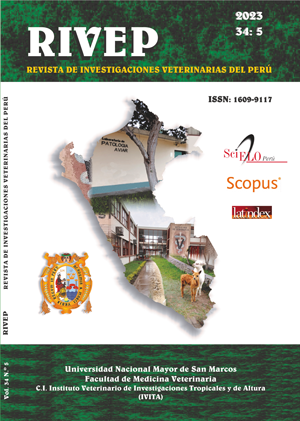Agronomic and nutritional assessment of cut-and-carry tropical grasses harvested at different intervals in Yurimaguas, Peruvian Amazon
DOI:
https://doi.org/10.15381/rivep.v34i5.24461Keywords:
forage grasses, frequencies, defoliation, tropicsAbstract
Four tropical grasses were evaluated: Maralfalfa (Pennisetum violaceum Lam), Purple King grass (P. purpureum x P. typhoides), Elephant grass (Pennisetum purpureum, Schumach) and Guatemala grass (Tripsacum laxum, Nash) with two harvest intervals (45 and 70 days), using a factorial experiment with a randomized complete block design. The interaction pastures × cutting frequencies was significant (p<0.05) for the agronomic and nutritional characteristics. Purple King Grass and Guatemala harvested at 70 days produced higher dry matter yield (17.13 and 17.03 t ha-1, respectively) than Maralfalfa, Purple King Grass, Elephant grass, and Guatemala grass harvested at 45 days. Compared with other grasses, the Guatemala grass harvested at 45 days had the highest leaf: stem ratio (4.64). The highest average contents of protein (78.5 g kg-1) and phosphorus (1.22 g kg-1) were obtained at 45 days. It is concluded that the grasses harvested at 70 days showed their productive potential with a moderate nutritional value, which could be used to increase the yield per unit area. In addition, Guatemala grass could be used in studies with grazing animals due to its high leaf: stem ratio and moderate nutritional value.
Downloads
Downloads
Published
Issue
Section
License
Copyright (c) 2023 Karen Rupay T., Gustavo Ampuero T.; Carlos Vela G.; Carlos Angulo V., Marco Mathios F., Ramiro Torres S.

This work is licensed under a Creative Commons Attribution 4.0 International License.
AUTHORS RETAIN THEIR RIGHTS:
a. Authors retain their trade mark rights and patent, and also on any process or procedure described in the article.
b. Authors retain their right to share, copy, distribute, perform and publicly communicate their article (eg, to place their article in an institutional repository or publish it in a book), with an acknowledgment of its initial publication in the Revista de Investigaciones Veterinarias del Perú (RIVEP).
c. Authors retain theirs right to make a subsequent publication of their work, to use the article or any part thereof (eg a compilation of his papers, lecture notes, thesis, or a book), always indicating the source of publication (the originator of the work, journal, volume, number and date).










